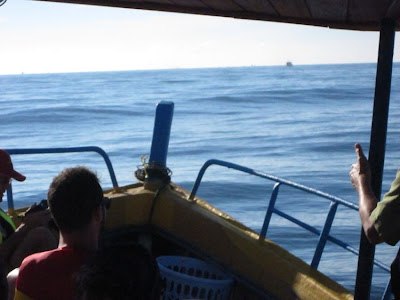 |
| Waiting for the whales, Mirissa, Sri Lanka... |
I was fortunate enough to spend Christmas and New Year 2012 in Sri Lanka, mainly on the south coast but also inland in the hills. It was a holiday, but I'd hoped to maybe do a travel article on the whale watching in Mirissa.
A few years back conservationists discovered that the ocean to the south of Mirissa, which is on the very tip of Sri Lanka, is prime Blue Whale habitat. In fact, it's one of the best places in the world to see Blue Whales. This quickly spawned a whale watching industry, which was for a while a little out of control.
In 2012 new rules were brought in to regulate the industry, but, having gone, it feels like there is still quite some way to go. These were my thoughts soon after returning from a five hour trip...
So Mirissa was nice, but overdone. It's promoted as a remote, deserted, picture postcard beach but in reality it's not the best beach in the world, it's just a fairly small beach in the tropics. It gets washed when the waves come in, the restaurants are too close to the sea, and there's little shade. Plus the food is aimed at mass market and not good relative to much of the rest of Sri Lanka. It is nice, don't get me wrong, but it's not isolated or undiscovered.
Old Mirissa is still there of course: we investigated the beautiful older hotels and guesthouses up on the headland, and there are the backpacker surfer type places on the beach road itself, and there is the village and the ayurvedic places, but really, it's on the cusp of being swallowed by a low-rent tide that will replace timeless natural beauty with the quickest buck. Visit in the off season [I was there at the very peak season] and it's sure to be nicer.
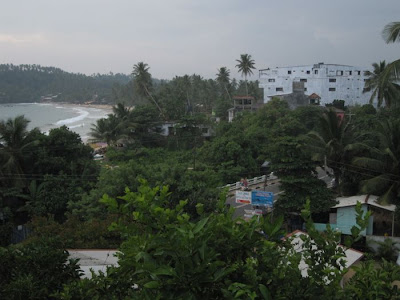 |
| New hotel development in Mirissa, Sri Lanka, December 2012 |
Mirissa is also famous now for whale watching. This is again meant to be controlled, but looks a little out of control. According to an article in Sri Lankan Airlines' in-flight magazine the Whale and Dolphin Conservation Society have been out in Mirissa recently helping establish some ground rules, and certainly from what we saw there is talk of being licensed. At sea all the boats stuck to the basic rules: don't go in front or behind, stay 100m to either side, follow don't chase, idle engines. But it still felt like a devalued experience.
The idea of whale watching for the engaged tourist is that they observe the whale in its natural habitat. This involves respect, quiet, consideration and, hopefully, a little selfishly, some sort of breathtaking display on the whale's (or other animal's) part.
We want to learn something, come away personally enriched, with an experience to treasure while at the same time leaving the whale or animal undisturbed by our presence – and if at all disturbed, then disturbed somehow positively (how this could be, I don't know, but I imagine it's got a lot to do with David Attenborough speaking in a hushed whisper while being groomed by gorillas in Rwanda). At least that's what I reckon people want. This was not really the case with us.
We joined the boats at 7am, arriving at pretty little Mirissa harbour just before. Mirissa is very much a working harbour: lots of fishing boats, the odd sailing boat, and on the day we were there a super slick catamaran that looked like it was on a round the world trip: its young-looking, shiny blonde-haired captain was already out running along the harbour walls with his top off, heart rate monitor on, looking like an advert for early retirement from a hedge fund on Wall Street.
We were the last to leave and chugged out at 7.30am. While still in the harbour there was a to-do about life jackets. They had been handed out but there weren't enough. One of the crew came round and took a few from some of the guys, including me. "Swim ok?" he asked, before giving it to a Chinese woman and adding, "Ladies first."
The whales pass around the tip of Sri Lanka on their annual migration. Blue Whales and Sperm Whales are common. This is an incredible thing: these are rare, rare beasts. Blue whales use these plankton rich waters for calving and often hang around with their newborns for several days. Others simply swim through.
They travel about eight miles (12km) offshore, exactly in the shipping channel apparently according to a guide we talked to in Galle (not a guide on the boat - there were none, and in fact the crew weren't exactly sure what the whales were that we saw, or if they were they just said "blue whale" when asked as they know everyone wants to see the blue).
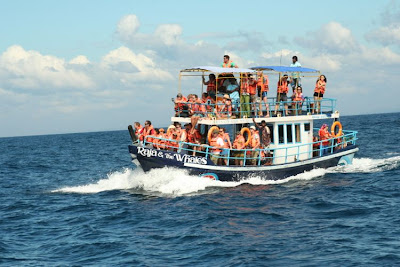 |
| Raju and the Whales, one of the more popular whale watching outfits in Mirissa, and one of the only local operators to get a write-up in the Sri Lanka Lonely Planet |
We chugged along at about 4 or 5 knots. I mean, I have never been in a slower boat. It was simply painful. Ahead of us we could see the rest of our whale-watching fleet. At one point I counted 15 boats, each with around 30 whale watchers on board. At one point a large, fast, sleek white catamaran capable of holding probably 300 people arrived too – the whale watchers from Galle. There must have been at least 600 people on the water the morning we went out.
The way it worked was the boats would spot a whale and then converge on it. They'd then bob along for a bit before the whale dived. The boats would then fan out and head in the general whale direction. It would be spotted again and the boats would converge again. In this way the fleet followed the whales through 'Mirissa' waters.
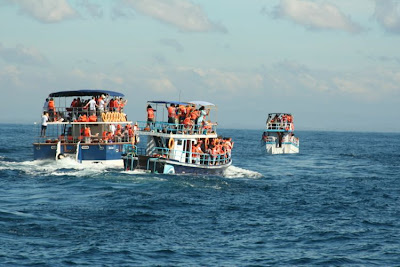 |
| Following the crowd on the lookout for Blue Whales off Mirissa |
Stuck at the back we watched the fleet converge and fan out at least twice if not thrice before we caught up. When we did catch up we arrived as a whale dived and then followed it with the rest of the boats. "What is it now, chase the whale?" a passenger said to me.
We spent perhaps an hour in the vicinity of whales. That means hanging out waiting for them, catching sight of a blow, seeing them come to the surface, the water taking on an oil-like quality of calm as they swam along just below the surface, their long bodies just visible as they turned and silently dived below. Once we saw a tail break the water.
 |
| This is not going to win Wildlife Photographer of the Year... Blue Whale tail, out of focus and very small. Perhaps he is running away from us... |
These moments are truly moments to savour. Animals in their natural habitat are always notable for their elegance, their efficiency. Nothing is wasted, no movement is unwarranted, it is perfection, a balance of nature. Their is no fat, no slackness, no laziness, no slothfulness greed or anger: it's truly Garden of Eden and it is a privilege to be there.
But these moments were very slight and very few on our boat of 40 that day. It rocked considerably as people shifted port or starboard, the minimal swell made I reckon one third of the people queasy, with several extremely seasick for hours, and the lack of guide, the lack of interpretation made it feel voyeuristic and shallow.
"You need to go with a conservationist," someone said later, and I realised (again) this is exactly true.
You need (I need) someone to give context, explain behaviour, to identify species. What you don't need is a plastic-wrapped sandwich of tube-cheese and white bread smelling of engine grease for breakfast, which is what we all got.
What would I look for in a whale watching tour again? What do I think would make whale watching in Mirissa a better experience?
- Better boats that are faster so you don't spend three hours out of four travelling to and from the whale zone, with zero-emission engine
- Smaller groups: 20 max
- Lifejackets for all, it's just obvious
- At a minimum a written explanation onboard of what's what: what you're looking for, why the whales are there, basic context
- At a maximum a guide who is conservation trained
- Fewer boats in the zone.
The lack of the above all contributed to a day that I felt degraded the experience and degraded us. It should be a memorable, informative, educational day, but it was none of those things.
Treating an encounter with our planet's greatest ever living thing as a trip to the zoo, albeit one that is carried out with at least a little bit of reverence (the crew love the whales, love looking for them, know the sea and their environment), is really a pretty poor way to do it – for us as visitors and for the boat operators too.
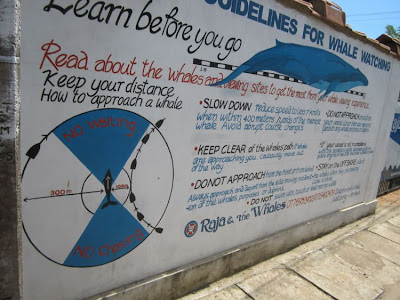 |
| Whale watching guidelines in Mirissa |
Meanwhile, who knows what the whales feel: at best they don't notice the 500 people watching their every move for five miles and swim on for the next thousand without a flicker, at worst their feeding and calving patterns are disturbed and they leave the area and change their behaviour.
Would I recommend it? No. At least not organised through a bog standard local operator for the 2,400-6,000 rupee mark (£12-£30) we were quoted. Instead, I'd say save up and do it properly, with a more expensive conservation-backed operator. At the minimum I'd ask more questions before setting off and I'd make sure there was a guide onboard, not simply crew. I would not join the 7am throng again.








0 comments:
Post a Comment